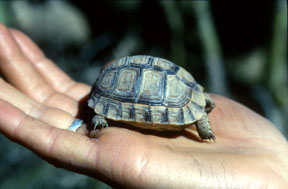
![]() Hibernating Juvenile Tortoises
Hibernating Juvenile Tortoises
A. C. Highfield

A juvenile Testudo graeca graeca from Morocco - can it hibernate?
The hibernation of juvenile Mediterranean tortoises is a much-vexed issue and causes many keepers a great deal of concern. To hibernate or not to hibernate, that is the question…
In the wild the vast majority of Mediterranean tortoises do hibernate over winter. There are exceptions, however. These include populations which live in regions which experience very mild winters, such as southern Morocco and Spain, or the coastal regions of Tunisia and Libya. In these areas, winter daytime temperatures typically exceed 20şC, and can reach 28şC. Here, tortoises remain fully active and feeding all winter. These same regions also experience exceptionally hot and dry summers. In southern Morocco, for example, daytime temperatures in July can exceed 48şC. These high temperatures, and the almost total lack of plants suitable for grazing, result in aestivation. The tortoises bury themselves underground and sit out the unbearable heat expending as little energy as possible. Although superficially similar to hibernation, aestivation is biologically a very different process and the two should not be confused. They are only similar in the sense that they result in a seasonal period of inactivity. This naturally affects the rate of growth and the total food intake over a 12-month period
If you keep tortoises from these localities they should be overwintered indoors and provided with adequate light and heat to enable continued feeding and a normal activity cycle.
Most other tortoises do hibernate. The basic facts on how to manage hibernation for adults are explained in the free Tortoise Trust publication Safer Hibernation And Your Tortoise. Juveniles can also be hibernated, and in general a period of hibernation is beneficial as it results in much more natural rates of growth than does continual activity.
There are two vitally important facts which must be understood:
- Juveniles require the same safe temperature range as adults for a safe hibernation, i.e., 4şC-6şC, but their gut pass-through time is very much shorter, typically no more than two to three weeks during which gradual cooling down should be undertaken.
- Because of their low body mass juveniles are very susceptible to rapid changes in the local temperature. In other words, they can freeze or become too warm very quickly indeed. For this reason, some extra precautions are necessary.
There are two approaches to the hibernation of juveniles, both of which have proved successful. These approaches have some similarities, especially in respect of the induction period.
For the first method the tortoises should be maintained as for overwintering, ie with light and heat, until at least mid-November. In very mild winters when inducing hibernation can be difficult, it may be necessary to keep them active until December. Begin the induction process by gradually reducing the hours of artificial light daily. At the same time, gradually begin reducing the temperature until the juveniles become inactive. During this period provide access to water daily. A small bath with slightly warm water is the most effective method of encouraging drinking.
After two or three weeks during which no feeding has occurred, the juveniles are ready for hibernation and can be packed into well insulated boxes with shredded paper packing, and placed in a room with a stable temperature of approximately 5şC. USE A RELIABLE THERMOMETER AT ALL TIMES TO CHECK TEMPERATURES! Remember that juveniles can freeze very quickly, so take all necessary measures to guarantee that this cannot happen. By the same token, check regularly if temperatures begin to approach 10şC, when the juveniles may reactivate.
Most juveniles can be safely hibernated for a period of between eight and twelve weeks, and can be woken up about a month before the adults. The boxes should be placed in a warm room and as the tortoises begin to move they can be transferred to a brightly lit and warm terrarium.
The second method uses identical induction procedures but allows the juveniles to bury themselves in a large earth tray. This tray is then transferred to a cool room. No boxes are therefore used. This method has two theoretical advantages: a) the surrounding thermal mass of the earth tray reduces the danger of sudden core temperature fluctuations being experienced by the juvenile, and b) there is slightly less danger of dehydration occurring during hibernation.
Both methods have proven safety records and have been used with hatchlings only a few months old. The use of a refrigerator is another option, discussed in a separate article on this website.
More useful hibernation information on this site:
Safer Hibernation and Your Tortoise
Incorrect Use of Jackson Ratio
How to measure tortoises correctly for Jackson Ratio assessment
(c) Tortoise Trust 1995-2002